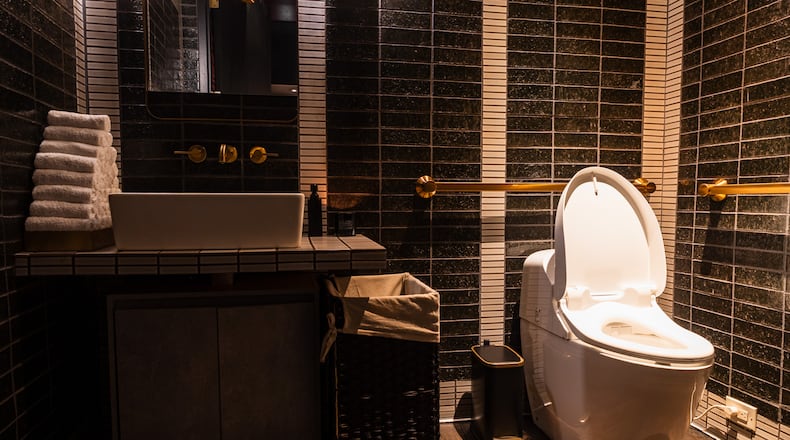Dinner at Mujo, one of Atlanta’s most highly regarded restaurants, is a daisy chain of delightful moments spread across two hours and more than a dozen courses. On my first visit to review the restaurant for The Atlanta Journal-Constitution, I didn’t expect one of those moments to come in the bathroom.
Like most of Atlanta’s omakase-style restaurants, Mujo is small, about 1,500 square feet. One bathroom serves all of the diners, many of whom will need to use the facilities in the course of their languid, luxuriant meal. Mujo’s alert staff keeps an eye out for guests who break focus from the chefs performing their precise sushi rituals to peer around for the restroom; with a discreet word, a staff member will escort the guest in need to the water closet.
Without knowing what to expect, my first visit to Mujo’s toilet was nothing short of a spectacle. Spot-lit like a futuristic throne, the lid opens automatically as you enter the room. A wall-mounted electronic control panel allows you to lift the heated seat, though if you start to raise it by hand, its electric motor kicks in and lifts it for you, like a haughty butler affronted by a clueless guest.
Credit: Henri Hollis
Credit: Henri Hollis
When I returned to my seat, I was excited to report the experience to my wife, who was similarly impressed with her visit. Since then, as Mujo racked up commendations like my own four-star review and a Michelin star, I’ve spoken with many others who have dined there, and the toilet is mentioned more often than not.
Atlanta’s omakase renaissance has created a class of restaurants where obsessive attention to detail extends to every part of the customer experience, including the bathroom. In those that have control over their bathroom space, such as Mujo, Omakase Table and Ryokou, it stands to reason the room’s primary appliance would further emphasize an atmosphere of Japanese-influenced luxury.
“I think it’s part of the experience,” chef Leonard Yu of Omakase Table and Ryokou told the AJC.
Luxe bathrooms are nothing new in the high-design world of fine dining, but these new, multifunctional toilets are unfamiliar to many Americans. A YouGov poll from 2023 reported that just 6% of Americans have a bidet in their homes, despite an explosion of interest in the bathroom accessories in recent years attributed to the toilet paper shortages of the COVID-19 pandemic.
At Ryokou, the staff understands the black Trone-brand smart toilet might not be intuitive for guests, with its LED screen and wall-mounted control pad covered in rune-like symbols. They escort diners to the single bathroom when they need to go and give a quick tip for how to flush the toilet, which is activated by a button on the tank rather than a traditional lever or handle.
Credit: Henri Hollis
Credit: Henri Hollis
Anyone interested in buying a similar model for their home can find Trone toilets at a couple of metro Atlanta showrooms, but expect to pay a premium for a black toilet. Online, the brand sells two models for $3,700 and $4,500 apiece.
Federico Castellucci, CEO of the Castellucci Hospitality Group, which owns Mujo, told the AJC a high-end Japanese toilet was always part of their plans. The top-of-the-line Toto model at Mujo has “all the bells and whistles” and cost several thousand dollars, Castellucci said, though he did not share an exact amount.
In many ways, these upscale toilets are assets to the restaurants, even beyond the surprise and delight they bring to customers. These are not expansive cathedrals of cuisine with space to roller skate between tables like in Disney’s “Ratatouille.”
In these small spaces, toilet features like self-cleaning, odor suppression and automated lids become invaluable. Toilet lids that automatically close when the user leaves ensure no guest finds the seat up when they enter the bathrooms, which are typically unisex.
Not every omakase restaurant has a space-age commode; some — such as Hayakawa in West Midtown — do not have bathrooms within their own space, and some cannot logistically accommodate them.
Many luxurious toilets are wall-mounted and have control pads hardwired into the wall, factors that must be taken into consideration during the design and construction process. Yu said he wanted nicer toilets at the first iteration of Omakase Table, but the bathrooms didn’t have power in the right places.
That was an issue he rectified at the new Omakase Table, which opened in Buckhead in March. There he installed identical Woodbridge smart toilets in the men’s and women’s bathrooms, which are denoted by boy and girl maneki-neko (beckoning cat) figurines.
Credit: Henri Hollis
Credit: Henri Hollis
But Yu said he didn’t have to look hard to find the upscale toilets he wanted at his flagship restaurant; as American interest in bidets increased in recent years, major retailers began stocking toilets that were once considered eccentric luxuries.
“I got them from Home Depot,” Yu said about his new toilets with a laugh. Each cost about $1,500.
Sign up for the AJC Food and Dining Newsletter
Read more stories like this by liking Atlanta Restaurant Scene on Facebook, following @ATLDiningNews on X and @ajcdining on Instagram.
About the Author
Keep Reading
The Latest
Featured






